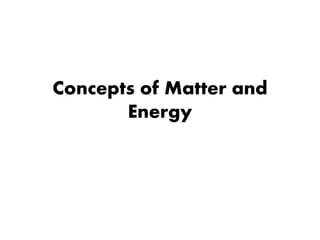
Concepts of Matter and Energy
- 2. Matter - It is anything that occupies space and has mass.
- 4. Matter * Solids- Has shape and mass. * Liquids- Has mass but it conforms the shape of its container.
- 6. Changes that occur: Physical Change- Change that occurs commonly in solid materials but are possible to happen in liquid materials like water.
- 7. Water, when put on a fridge becomes ice and when put outside the fridge, it melts due to the exposure of water into the high temperature of the environment. It is physical change because wether the water change into two forms, it maintains its
- 9. Chemical Change- A change that usually happens when the components of the material (or variable) are interchanged.
- 11. Energy - It has a less mass - Do not take up space - Means– ability to work - It puts matter into motion • Kinetic Energy- Energy in motion. • Potential Energy- Stored energy. (E.g. Batteries)
- 12. Forms of Energy • Chemical Energy • Electrical Energy • Mechanical Energy • Radiant Energy
- 13. Chemical Energy -Stored in the bonds of chemical substances. • How bonds are broken? - The stored energy is unleashed and becomes kinetic energy. (From potential to kinetic) E.g. Gasoline Molecules
- 15. Electrical Energy - Results from movement of charged particles. E.g. In your house. (flow of electrons)
- 17. Mechanical Energy - Directly involved in moving matter. E.g. When you ride a bicycle. It basically consumes your stored energy from the foods you eat. It is through the process catabolic metabolism.
- 19. Radiant Energy - It is the energy of electromagnetic spectrum. - It travels in waves. • Commonly used in: - X-Rays (in medical purposes) - Infrared (usually on smartphones near 2000’s) - Visible light (From florescent lights at home) - Radio (As you observe, it uses
- 21. Energy Form Conversions - With few exceptions energy is easily converted from one form to another. E.g. Electrical energy Light energy
- 22. Always remember, “ All energy conversions that occur in the body liberate heat.” “ When matter is heated, its particles begin to move more quickly (like when a matter is about to combust); that is their kinetic
- 23. Composition of Matter • Elements - Unique substances that can’t be broken down into simpler substances. - Such as: Oxygen, Carbon, Gold, Copper and Iron.
- 24. Additional Knowledge: 112 Elements are known with certainty, 113-116 are alleged 92 of these elements occur naturally and
- 25. Chemical Elements that made up 96% of body weight: • Carbon • Oxygen • Hydrogen • Nitrogen
- 26. Atoms - Building block of an element - Smallest particle that still remains its special properties.
- 27. Atomic Symbol - One or two-letter chemical shorthand
- 28. Atomic Structure - Atom– gk. Incapable of being divided. - It is accepted as a scientific truth. “According to this notion, you could theoretically divides pure element such as block of gold into smaller and smaller particles until you
- 29. The atoms representing the 112-plus elements are composed of different numbers and proportions of three-basic sub-atomic particle which differs in mass, electrical charge and location within the atom.
- 30. • Proton (p⁺) – Have positive charge. • Neutron (n⁰)- Uncharged one or neutral - They are heavy particles and they have approximately the same mass. • Electrons (e⁻)- They are tiny and
- 31. Electrical Charges Positive to Positive Negative to Negative They repel each other
- 32. Positive to Negative Negative to Positive They attract each other
- 33. Neutrals nor attract or repel each other.
- 34. The number of protons is equal to the number of electrons because they cancel out the effect of each other. • Ions are atoms that have gained or lost electrons.
- 35. Planetary and Orbital Model of an Atom • Planetary Model of an Atom - Portrays the atom as a miniature solar system in which protons and neutrons are clustered at the center of the atom at the atomic nucleus. *Nucleus- Contains heavy particles
- 36. • Orbital Model - The electrons outside the nucleus is represented by the electron cloud. In which electrons are more present in the denser shaded part of the model.
- 37. How to Identify Elements? Based on the following: 1.Atomic Number 2.Atomic Mass 3.Atomic Weight
- 38. 1. Atomic Number - Is equal to the number of protons its atom contain. - Atomic number of an atom is unique.
- 39. 2. Atomic Mass Number - The sum of the protons and neutrons. The mass of electron is so small that it is usually ignored.
- 40. 3. Atomic Weight Depends on the Isotopes - Isotopes has the same number of protons and electrons but different in the number of neutrons. Thus, isotopes of an element has the same number of atomic number but have different atomic masses.
- 41. Radioisotopes - Heavy isotopes - Unstable and tend to decompose to become more stable. • Radio Activity- Spontaneous atomic decay.
- 42. Thank You! Prepared by Pulleymazzzing Elaine N. Marieb’s Essentials of Human Anatomy and Physiology, 8th Ed., pp. 26-32
